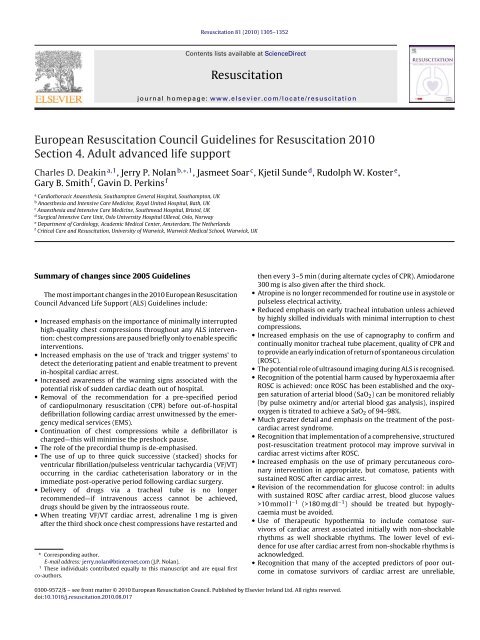European Resuscitation Council Guidelines for Resuscitation 2010 ...
European Resuscitation Council Guidelines for Resuscitation 2010 ...
European Resuscitation Council Guidelines for Resuscitation 2010 ...
Create successful ePaper yourself
Turn your PDF publications into a flip-book with our unique Google optimized e-Paper software.
<strong>Resuscitation</strong> 81 (<strong>2010</strong>) 1305–1352<br />
Contents lists available at ScienceDirect<br />
<strong>Resuscitation</strong><br />
journal homepage: www.elsevier.com/locate/resuscitation<br />
<strong>European</strong> <strong>Resuscitation</strong> <strong>Council</strong> <strong>Guidelines</strong> <strong>for</strong> <strong>Resuscitation</strong> <strong>2010</strong><br />
Section 4. Adult advanced life support<br />
Charles D. Deakin a,1 , Jerry P. Nolan b,∗,1 , Jasmeet Soar c , Kjetil Sunde d , Rudolph W. Koster e ,<br />
Gary B. Smith f , Gavin D. Perkins f<br />
a Cardiothoracic Anaesthesia, Southampton General Hospital, Southampton, UK<br />
b Anaesthesia and Intensive Care Medicine, Royal United Hospital, Bath, UK<br />
c Anaesthesia and Intensive Care Medicine, Southmead Hospital, Bristol, UK<br />
d Surgical Intensive Care Unit, Oslo University Hospital Ulleval, Oslo, Norway<br />
e Department of Cardiology, Academic Medical Center, Amsterdam, The Netherlands<br />
f Critical Care and <strong>Resuscitation</strong>, University of Warwick, Warwick Medical School, Warwick, UK<br />
Summary of changes since 2005 <strong>Guidelines</strong><br />
The most important changes in the <strong>2010</strong> <strong>European</strong> <strong>Resuscitation</strong><br />
<strong>Council</strong> Advanced Life Support (ALS) <strong>Guidelines</strong> include:<br />
• Increased emphasis on the importance of minimally interrupted<br />
high-quality chest compressions throughout any ALS intervention:<br />
chest compressions are paused briefly only to enable specific<br />
interventions.<br />
• Increased emphasis on the use of ‘track and trigger systems’ to<br />
detect the deteriorating patient and enable treatment to prevent<br />
in-hospital cardiac arrest.<br />
• Increased awareness of the warning signs associated with the<br />
potential risk of sudden cardiac death out of hospital.<br />
• Removal of the recommendation <strong>for</strong> a pre-specified period<br />
of cardiopulmonary resuscitation (CPR) be<strong>for</strong>e out-of-hospital<br />
defibrillation following cardiac arrest unwitnessed by the emergency<br />
medical services (EMS).<br />
• Continuation of chest compressions while a defibrillator is<br />
charged—this will minimise the preshock pause.<br />
• The role of the precordial thump is de-emphasised.<br />
• The use of up to three quick successive (stacked) shocks <strong>for</strong><br />
ventricular fibrillation/pulseless ventricular tachycardia (VF/VT)<br />
occurring in the cardiac catheterisation laboratory or in the<br />
immediate post-operative period following cardiac surgery.<br />
• Delivery of drugs via a tracheal tube is no longer<br />
recommended—if intravenous access cannot be achieved,<br />
drugs should be given by the intraosseous route.<br />
• When treating VF/VT cardiac arrest, adrenaline 1 mg is given<br />
after the third shock once chest compressions have restarted and<br />
∗ Corresponding author.<br />
E-mail address: jerry.nolan@btinternet.com (J.P. Nolan).<br />
1 These individuals contributed equally to this manuscript and are equal first<br />
co-authors.<br />
then every 3–5 min (during alternate cycles of CPR). Amiodarone<br />
300 mg is also given after the third shock.<br />
• Atropine is no longer recommended <strong>for</strong> routine use in asystole or<br />
pulseless electrical activity.<br />
• Reduced emphasis on early tracheal intubation unless achieved<br />
by highly skilled individuals with minimal interruption to chest<br />
compressions.<br />
• Increased emphasis on the use of capnography to confirm and<br />
continually monitor tracheal tube placement, quality of CPR and<br />
to provide an early indication of return of spontaneous circulation<br />
(ROSC).<br />
• The potential role of ultrasound imaging during ALS is recognised.<br />
• Recognition of the potential harm caused by hyperoxaemia after<br />
ROSC is achieved: once ROSC has been established and the oxygen<br />
saturation of arterial blood (SaO 2 ) can be monitored reliably<br />
(by pulse oximetry and/or arterial blood gas analysis), inspired<br />
oxygen is titrated to achieve a SaO 2 of 94–98%.<br />
• Much greater detail and emphasis on the treatment of the postcardiac<br />
arrest syndrome.<br />
• Recognition that implementation of a comprehensive, structured<br />
post-resuscitation treatment protocol may improve survival in<br />
cardiac arrest victims after ROSC.<br />
• Increased emphasis on the use of primary percutaneous coronary<br />
intervention in appropriate, but comatose, patients with<br />
sustained ROSC after cardiac arrest.<br />
• Revision of the recommendation <strong>for</strong> glucose control: in adults<br />
with sustained ROSC after cardiac arrest, blood glucose values<br />
>10 mmol l −1 (>180 mg dl −1 ) should be treated but hypoglycaemia<br />
must be avoided.<br />
• Use of therapeutic hypothermia to include comatose survivors<br />
of cardiac arrest associated initially with non-shockable<br />
rhythms as well shockable rhythms. The lower level of evidence<br />
<strong>for</strong> use after cardiac arrest from non-shockable rhythms is<br />
acknowledged.<br />
• Recognition that many of the accepted predictors of poor outcome<br />
in comatose survivors of cardiac arrest are unreliable,<br />
0300-9572/$ – see front matter © <strong>2010</strong> <strong>European</strong> <strong>Resuscitation</strong> <strong>Council</strong>. Published by Elsevier Ireland Ltd. All rights reserved.<br />
doi:10.1016/j.resuscitation.<strong>2010</strong>.08.017
















